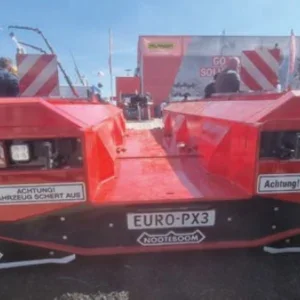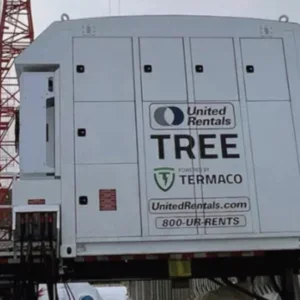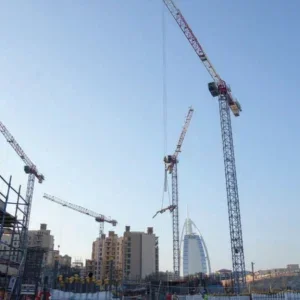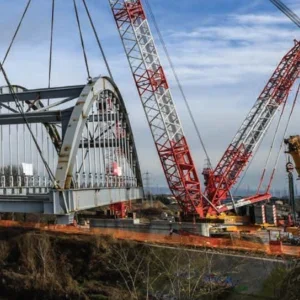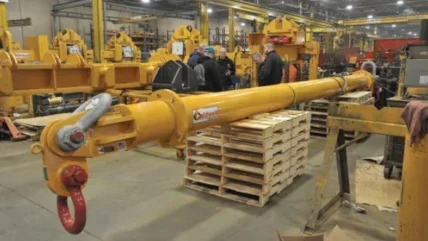
The below the hook equipment sector continues to evolve, playing an integral role in lifting across a diverse range of industries and projects worldwide. From groundbreaking scientific endeavours in space exploration to intricate offshore operations these essential tools are helping redefine what can be achieved in lifting.
Ohio, USA-headquartered PSC Crane & Rigging, for example, utilised two MOD 50 spreader beams made by Dorset, UKheadquartered spreader beam and lifting equipment manufacturer Modulift to help install a key part of a NASA research facility in Virginia, USA.
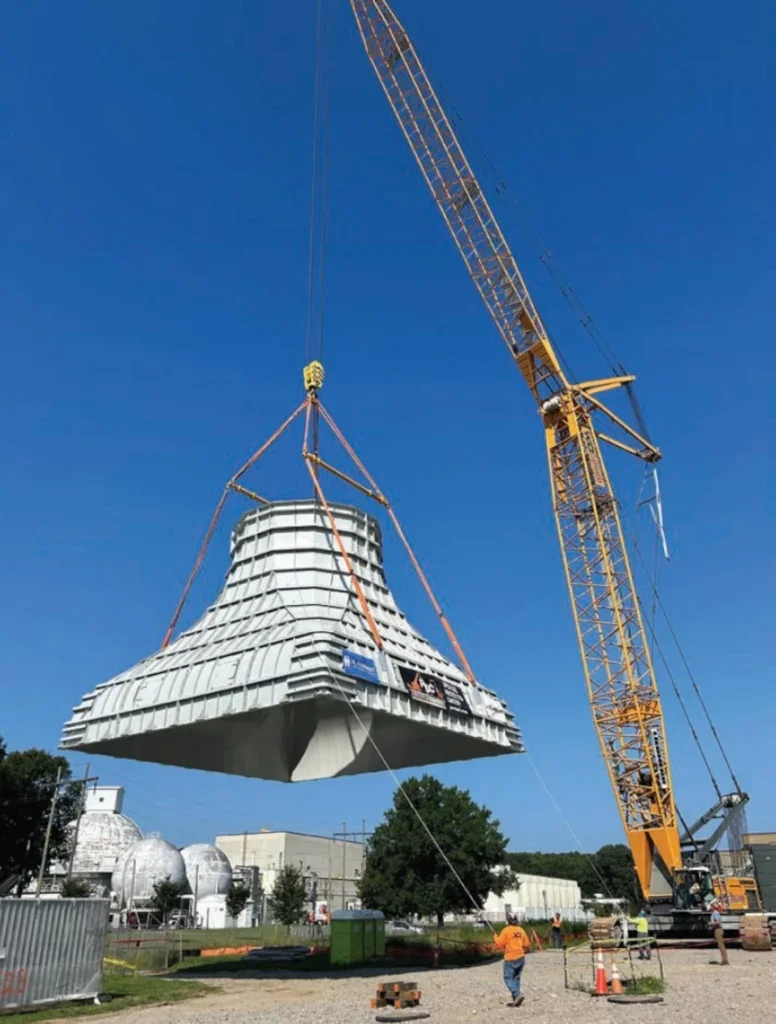
PSC used the MOD 50 spreader beams to create a four-point lift for the installation of a 120-foot vertical wind tunnel at NASA’s Flight Dynamics Research Facility, part of the Langley Research Centre in Hampton, Virginia.
It is the first major project of its kind for over 40 years and the 25,000-square-foot facility will support human exploration and science missions returning from the Moon and Mars. Additionally, it will contribute to the exploration of Venus and Titan, Saturn’s moon.
Since the late 1930s NASA researchers have used a 12-foot low speed tunnel and vertical spin tunnel. The new FDRF facility will have significantly greater capability than the two existing tunnels while greatly reducing maintenance and operating costs. The research facility will enable NASA and industry partners to study the flow of air travelling around aerospace vehicles.
“What we’re going to do with this facility is literally change the world,” said Clayton Turner, director of NASA Langley Research Centre. “The humble spirit of our researchers and this effort will allow us to reach for new heights, to reveal the unknown, for the betterment of humankind.”
OUT OF THIS WORLD
In another outer-space, sciencerelated project US-headquartered below the hook lifting solutions specialist The Caldwell Group delivered a custom system for lifting and rotating a track section during manufacture of the world’s most powerful telescopes. The construction of the telescope is one of the largest public-private funded science projects in history.
The Giant Magellan Telescope is under construction at Las Campanas Observatory in Chile’s Atacama Desert. The project has come about thanks to an international consortium of leading research institutions.
The 30-metre-class telescope will, when finished, offer ten times the viewing power of the Hubble Space Telescope.
Initially Caldwell manufactured a lifter/rotator based on a 242,500-lbs (110-tonne) capacity Dura-Mod modular spreader beam and two 20-tonne capacity RUD ACP-Turnado swivel hoist rings.
Below the beam, rotation and landing assemblies on each side of the load facilitate positioning and securement of the track section from Rockford, Illinois-based Ingersoll Machine Tools.
Two 85-ton capacity top shackles and two 55-ton capacity bottom shackles, also supplied by Caldwell, and lifting slings, are among other key components.
The spreader beam was positioned above, and connected to, the rotation assemblies fastened onto the track section.
The system was raised by a hoist and adjusted by crane controls to keep the landing assemblies on blocking as the section was upended. Existing holes on the load were utilised to fasten both the rotation and landing assemblies using M24 nuts and bolts.
The system was initially used to complete four lifts to flip and precision-machine both sides of the rotating track sections.
Telescopes and wind tunnels are just the tip of the iceberg, however, when it comes to the range of unusual objects that spreader and lifting beams are being used to help lift.
One reoccurring area of work that continues to utilise Modulift’s spreader and lifting beams, for example, relates to various modes of transportation: specifically aeroplanes, boats, and trains…
LIFTING PLANES
When it comes to planes over the last 18 years Modulift has worked closely with aircraft recovery solutions specialist AMS Aircraft Recovery – with Modulift’s modular MOD spreader beam being central to AMS’s Fuselage Lifting System and OWL Over Wing Lift systems.
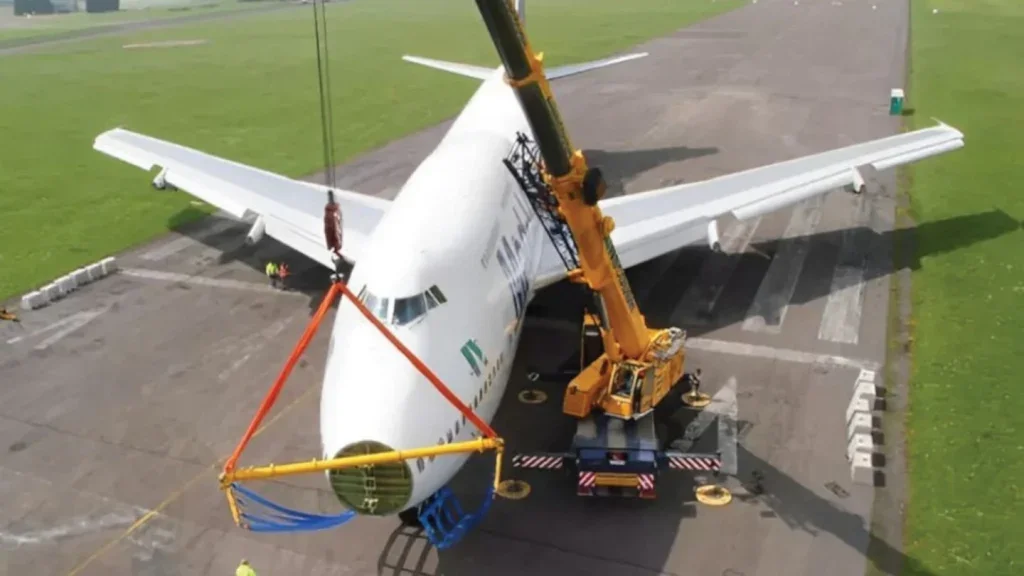
AMS has also utilised custom-built equipment from Modulift. Bespoke hanging plates accommodate both narrow and wide body aircraft in the Fuselage Lifting System and, most recently, a spreader beam for aircraft towing was added to their fleet.
Sarah Spivey, managing director at Modulift, said: “Our long-standing partnership with AMS Aircraft Recovery marks our commitment to bringing innovative lifting solutions to niche industries such as aerospace.”
Ponthir, Wales-based specialist transportation company Kyles Transport is another company that utilised a Modulift MOD spreader beam to lift an aeroplane.
It used a Modulift MOD 12 spreader beam to lift a Douglas DC-6 military aircraft that was used in World War II.
The historic plane was being relocated from Coventry to the South Wales Aviation Museum.
“Modulift’s below the hook products are our go-to pieces of equipment for lifting,” commented Kyle Hourihane, managing director at Kyles Transport. “In this case, the MOD 12 was used at a four metre span to allow us to lift the fuselage at its correct pick points along the aircraft.”
The task at hand involved transporting the cockpit section and main body of the aircraft.
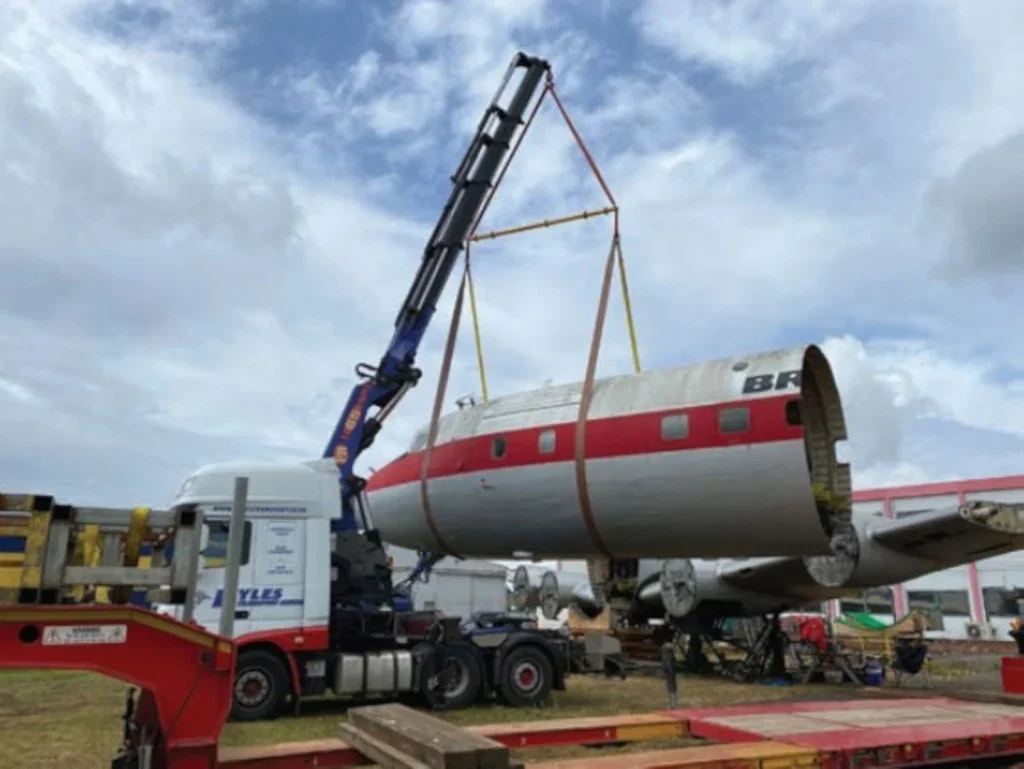
The plane measured 11 metres in length, with a width and height of 2.3 metres and 3.6 metres respectively.
To facilitate the lift, the MOD 12 spreader beam was used with a PM65 lorry loader crane, mounted to a DAF XF lorry. Slings and shackles were attached to the beam to ensure the safe lifting of the 4000kg aircraft.
BOAT LIFT
Abu Dhabi-headquartered logistics firm Al Jaber Heavy Lift & Transport lifted a wooden boat, measuring 40 metres long and ten metres high, at a Port in Qatar using three different Modulift spreader beams: a MOD 600XB/600, a MOD 250, and a MOD 110. The spreader beams were used in a ‘1-over-2’ lifting rig to safely manoeuvre the boat which had an uneven weight distribution.

In lifting scenarios such as these a ‘1-over-2’ configuration is often the most economical solution when there are no headroom restrictions, says Modulift.
The three different sized MOD spreader beams from Modulift’s off-the-shelf range allowed the crane to lift the boat despite the unevenly distributed weight.
“The 150-tonne boat was handcrafted in Kerala, India, and brought to Qatar waters,” said Fasin Abubacker, engineering manager at Al Jaber. “It required lifting onto the jetty in Qatar for further maintenance purposes. Our operations team was able to execute the lift safely and costefficiently at the port. We wouldn’t have been able to turn this lift around so quickly without the MOD spreader beam system. An uneven weight distribution during lifting can cause tilting or even catastrophic structural damage to the item being lifted. Using three different MODs in a ‘1-over-2’ configuration helped to negate these challenges.”
TRAIN LIFT
Japan-based lifting gear supplier Nakamura Industry and its customer lifted a high speed ‘bullet train’ in Taiwan using Modulift spreader beams.
The new EMU3000 intercity express train was the first of its type in the country and the spreader beams were deployed twice: once to load the train onto a boat in Japan and then again to offload the train when it arrived at Hualien Port in Taiwan.
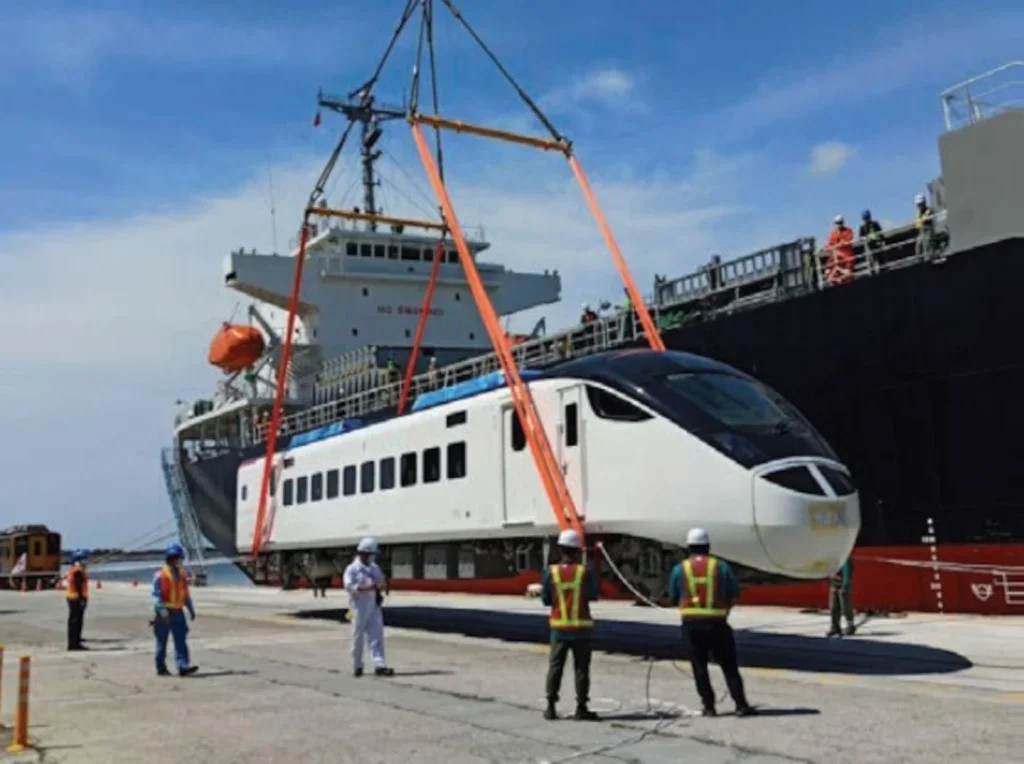
Two MOD 34 spreader beams, at a span of 3.5 metres, provided four lifting points underneath the train to evenly distribute the weight. The two spreader beams were attached to drop links and shackles at the end of each beam, with synthetic round slings below the beams, and wire rope slings above.
Osaka-based business Nakamura Industry is a distributor of Modulift spreader beams and delivers throughout Japan.
It also supplies a variety of products from wire rope and synthetic slings to hooks and shackles.
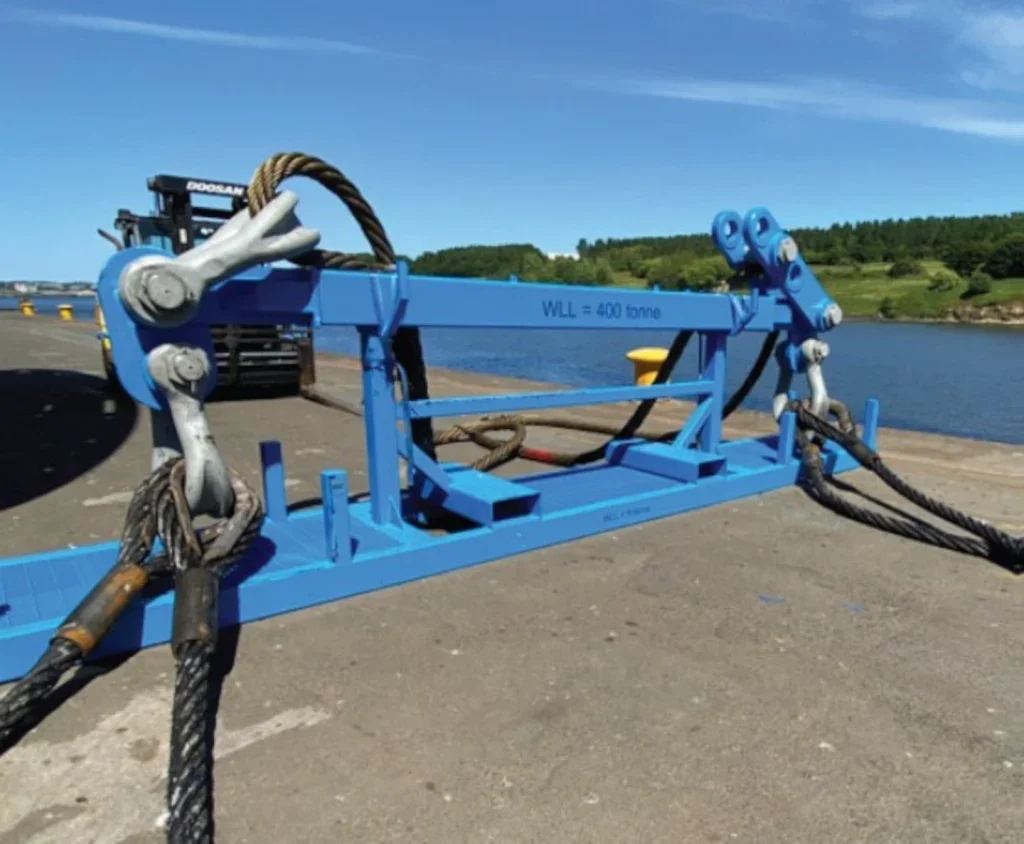
Sumihide Haruta, executive officer and general manager, Sales Division, at Nakamura Industry, commented: “The Modulift spreader beams’ adaptable design allowed our customer to safely configure the lift for the EMU3000. These beams were transported with the train, facilitating easy disassembly, shipping, and reassembly before offloading.”
OFFSHORE APPLICATIONS
Offshore work is also proving to be a key application area utilising lifting and spreader beams. Teesside, UK-based Tusk Lifting, for example, required a 400 tonne lifting beam to ensure safe lifting of giant subsea cable reels.
To realise this it turned to Dorset, UK, lifting beam, spreader beam and lifting frame designer and manufacturer Britlift.
“Our client needed a beam that could lift cable reels of up to 400 tonnes, with offset centres of gravity,” said Julie Montgomery, sales and systems support lead for Tusk Lifting.

Working closely with Tusk Lifting and its client, Britlift supplied a custom box spreader beam with a cradle/stand and heavy-duty sling adjustor.
Britlift’s technical team also specified a more hard-wearing paint job to better withstand offshore conditions. Britlift also supplied proof of load testing and MPI, with an enhanced quality pack which included an ITP, as well as welding maps with related procedures and qualifications, plus reports covering structural calculations and the paint spec.
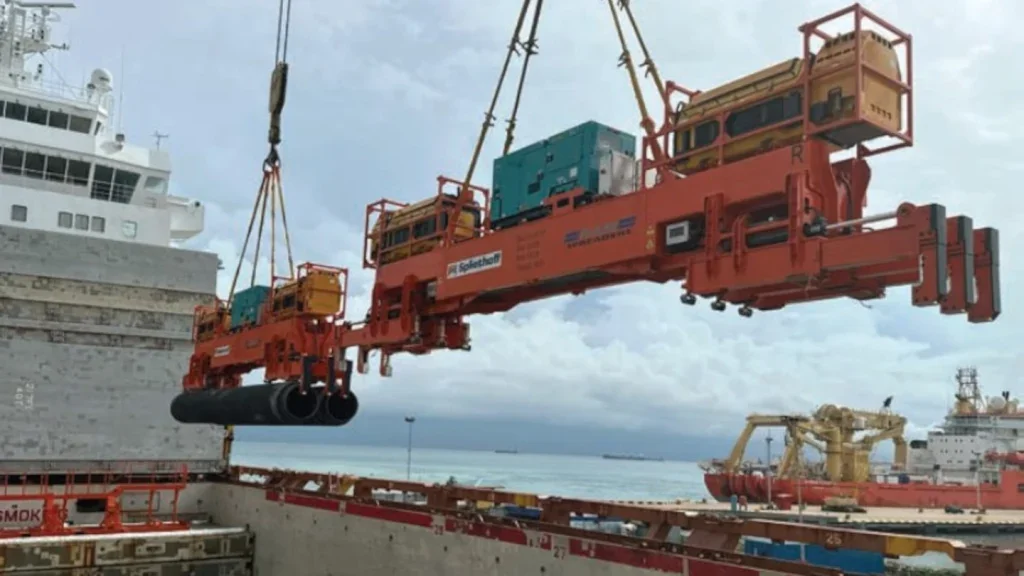
“The client has used smaller beams from Britlift and loved them, so it made sense for us to ask them to quote for these larger projects,” said Montgomery. “The client was so impressed that we awarded Britlift a contract for the next beam, which is 200t capacity.
Slings are another crucial piece of lifting equipment used below the hook in the offshore wind arena. In 2024 Groningen, Netherlandsheadquartered manufacturer of Extreema slings and polyester heavy lift soft slings Lift-Tex Heavy Lift Slings, for example, completed what it describes as ‘an immense order of slings’ for an offshore wind energy project. Within this order it made its largest sling ever with a capacity of 4200t MBL.
BLADE LIFTING BEAM
The handling and installation of wind turbine blades and rotors is another area in which below the hook products are key tools.
Memmingerberg, Germanyheadquartered machine and gripping technology specialist Ematec, for example, has collaborated with Danish engineering company Seasight Solutions to create a wind turbine rotor blade lifting beam that comprises Ematec’s RBC yoke combined with Seasight’s Automatic Positioning System (APS).
Two propellers are flangemounted to the traverse so that guide ropes can be dispensed with when installing the rotor blades.
The two propellers can compensate for higher wind speeds and are better at stabilising the rotor blade compared to the previous method of using guide ropes controlled by workers on the ground, Ematec claims.
This makes it possible to install rotor blades at wind speeds up to 10 m/s. The traditional approach worked at wind speeds up to 8 m/s, depending on the rotor blade type.
The system is being used by Enercon – a manufacturer and service provider for onshore wind turbines. “On average, using the APS saves us 2.3 working days per construction site, when otherwise installation would have to be put on hold because of weather conditions,” explains Klaas Schumann, Enercon site engineer.
The RBC and APS are controlled by two remote control units. One person controls the process from the ground until the component reaches a certain height; then, control is transferred to a second person in the hub who completes the lifting and installation process.
The energy supply is via a redundancy system with two power generators. This ensures that even if one generator fails, the component can still be lowered to the ground safely.
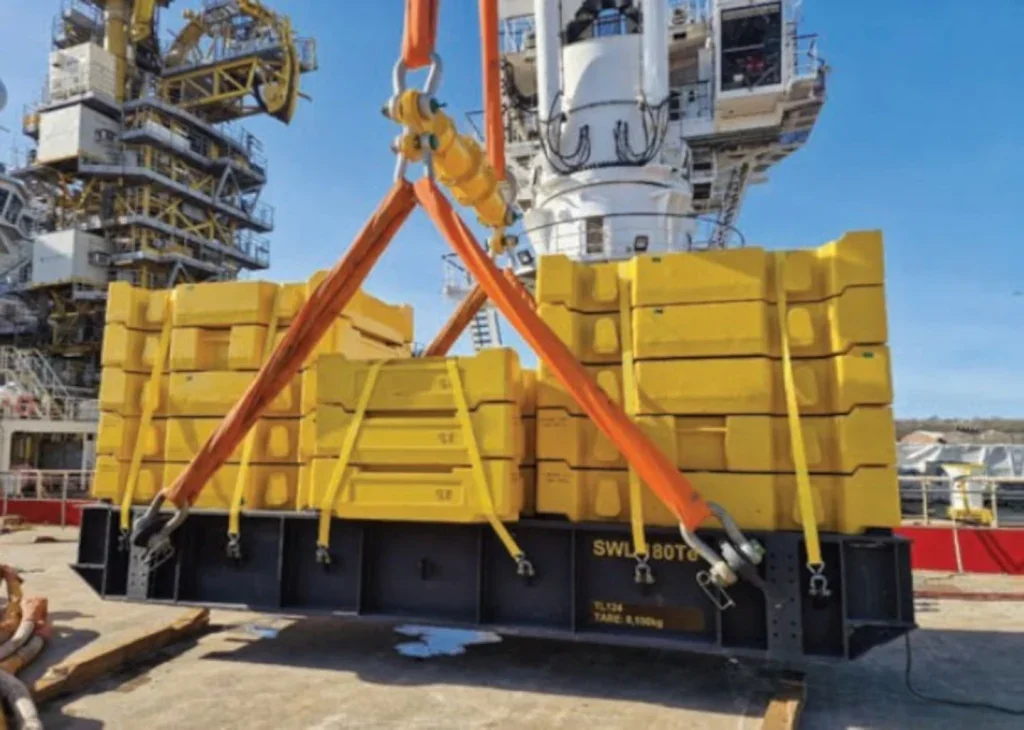
Doing away with the guide ropes has also reduced the working radius required for rotor blade installation. “In particular for challenging sites, such as in the forest or in the mountains, near the water or near major industrial sites, this new system makes work at the construction site faster, simpler and safer,” says Enercon equipment expert Gerhard Olthoff.
PIPE LIFTING
Another below the hook load control system being used to achieve efficiencies comes from Verton Technologies Australia.
Its SP30 rotational control stabiliser for spreader bars was used by Dutch shipping company Spliethoff Group in its pipe lifting operations for energy company Woodside’s USD $12.5 billion Scarborough Energy Project.
Twelve of Verton’s gyroscopic SP30 SpinPods were fitted to six automated pipe spreaders to control and maintain the orientation of the pipes during loading from the Port of Batam to the hold of the three supply vessels.
They were then used again during the transfer of the pipes from the three Spliethoff B type vessels to a Spliethoff D type vessel while out at sea.
Over 250 km of 12-metre-long pipeline sections were lifted in over 15,000 lifting operations, with no lost time injuries.
The SpinPods fitted to the pipe spreaders, manufactured by Ram Spreaders, allowed Spliethoff to execute these lifting operations with no taglines and no hands-on deck or in the hold.
The number of personnel required for lifting was reduced by 60%, and the planned transfer rate of 100 pipes per six-hour shift was exceeded by 40%.
By keeping the crew away from the pipeline sections during lifting, and aligning pipeline sections with the ship automatically, the SP30s contributed to improved safety and reduced cycle time.
Verton CEO, Stan Thomson said: “We appreciate Spliethoff and Woodside providing us with an opportunity to demonstrate the safety and productivity that Verton’s stabilisation and rotational control technology can bring to a major offshore lifting operation. Building on the success of the 12 Verton SP30s supplied for Spliethoff we are currently working on opportunities for improving productivity and safety by controlling spreaders for other major lifting operations.”
Verton has specifically targeted the maritime industry as a priority market due to the danger and expense of lifting whilst at sea. Verton is also targeting the offshore oil and gas, infrastructure, mining, energy, and construction industries.
LOAD TESTING COLLAB
Also serving the crane, marine and offshore industries is lifting solutions specialist Hendrik Veder Group UK which, in a strategic move to become a complete service provider, has announced a new cooperation with UK-based load test expert Test and Lift Engineering Services (Test and Lift).
The agreement will see the Scottish branch of Hendrik Veder Group UK diversify its output by offering a new regional service via the distribution and leasing of test weights supplied by Test and Lift.
As the Scottish agent for Test and Lift, Hendrik Veder Group UK will strengthen its load testing offering via the distribution of a greater portfolio of test weights.
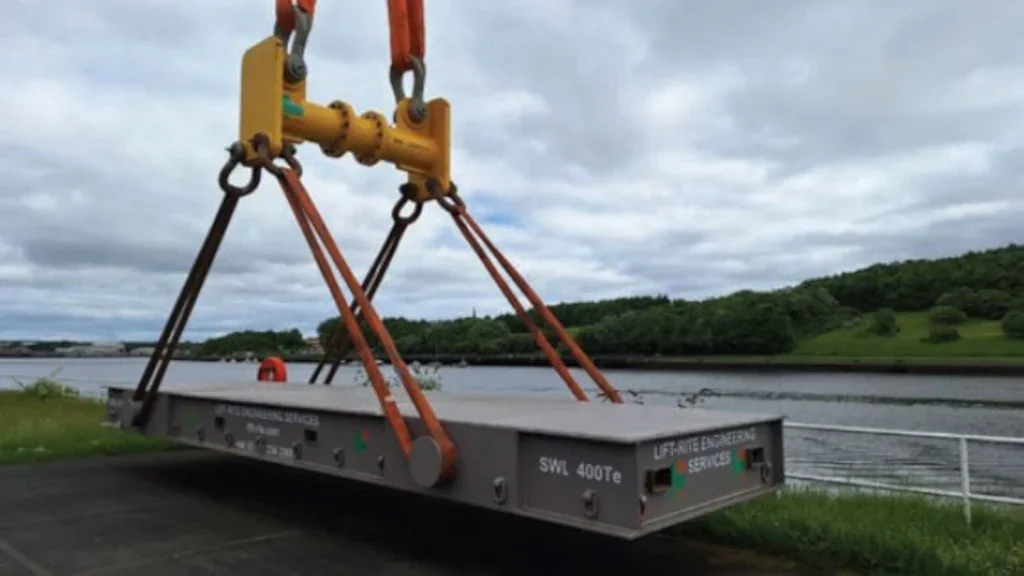
Utilising the yard space and in-house machinery at its Aberdeen facilities, Hendrik Veder Group UK will now be able to lease out more bespoke, smaller test weights for a greater variation of project needs and open the door to new opportunities.
Established as a modular solution Test and Lifts’ test weights were designed to be integrated depending on project requirements. These weights also address many of the health and safety risks commonly associated with their provision such as difficulty to handle, arrange, and secure, says Hendrik Veder.
This latest development follows a strengthened relationship between the two businesses and will support key aims on both sides. Via Hendrik Veder Group UK’s network of established operators and varied connections Test and Lift will now have a more accessible and cost-effective route to distribute solutions across Scotland. Together, both companies say they will be able to deliver tailormade test weight solutions with short delivery times.
NEW TEST CRADLE
In October 2024 Newcastle-Upon- Tyne, UK-based Lift-Rite has launched a new product in its load testing fleet: a load test cradle capable of lifting weights of up to 400 tonnes.
Lift-Rite designs, manufactures and tests bespoke mechanical equipment and systems used in the offshore and subsea industries, including test weights, cradles, and water bags. The business says it provides tailored and sustainable solutions to leading energy operators, wind farm developers, and offshore service companies across the globe.
According to Lift-Rite the 400-tonne cradle is the first of its kind in the UK. It is used in conjunction with the company’s 400-tonne modular spreader beam.
“By expanding the weight testing capability of our cradle range we are responding to market demand and the increasing requirements for challenging and heavier load tests,” said Andy Lovell, managing director of Lift Rite. “By expanding our fleet we can ensure we are meeting the complex and varied needs of the market with test weights solutions that deliver to our client’s requirements.
“Our new cradle and lifting beam arrangement offers something new to the market which simplifies large capacity load testing. Achieving capacities in this range usually requires at least two cradles with a multibeam rigging arrangement, demanding complex planning and higher hire costs.”
The above examples illustrate how the below the hook sector is continuing to evolve, playing an integral role in a diverse range of industries and projects worldwide. From supporting space exploration and advancing renewable energy to safely relocating historical artefacts like the Douglas DC-6 aircraft, below the hook solutions are continuing to push boundaries.
These lifting tools not only enable safer and more efficient operations but are also driving progress in some of the most ambitious and transformative projects of our time.
BRITLIFT BEAM: A ‘SWISS ARMY KNIFE’ FOR THE LIFTING INDUSTRY
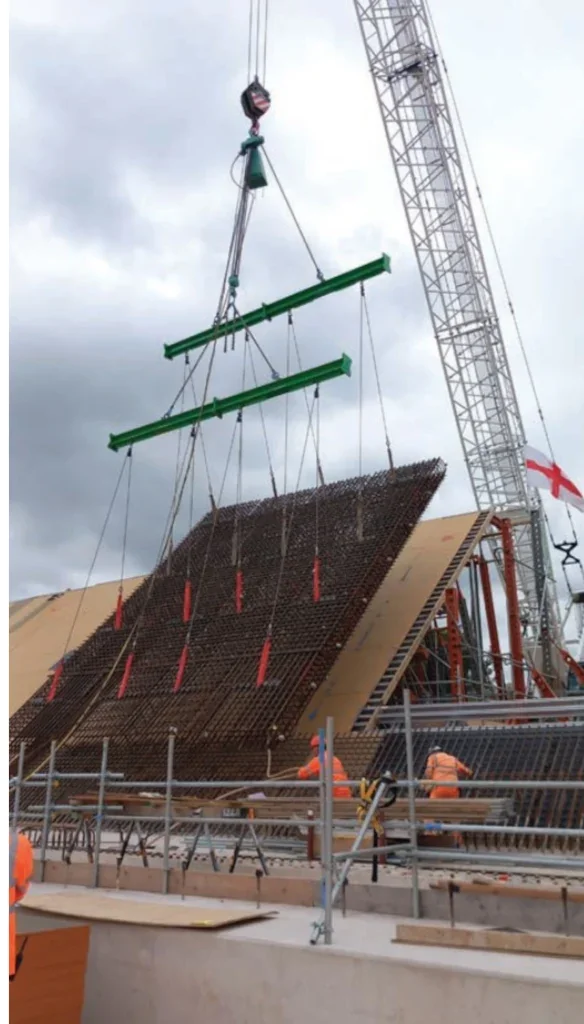
One of the latest new modular lifting beams on the market is from UK company Britlift. According to Britlift the Multilifter ML180 can be used as an under beam, a lifting beam, an H-frame or lifting frame with a 16-tonne safe working load (SWL), or a semi-spreader up to 23 tonnes. Adaptors include various types of lifting points, excavator hooks, trunnions, multi-point lifting arms, and clamps, with more already in development. Britlift claims it offers far more versatility than existing modular beams, while retaining the key benefi ts such as ease of transport and handling.
The first model went to UK equipment hire and solutions provider Sunbelt Rentals. Gary Joyice, director of lifting at Sunbelt Rentals, said: “This is a game-changer for the lifting industry. It offers more versatility than anything we’ve seen before – it is like the Meccano of lifting beams. The ability to quickly and easily configure it as multiple products will be warmly welcomed by lifting professionals and construction contractors.”
Sunbelt was so confi dent in the product that it placed an order based on the preliminary designs by Britlift. It has taken delivery of the fi rst consignment and has already supplied them to some of its biggest customers.
“The feedback we have received from our clients is impressive,” said Joyice. “One of the common challenges occurring on site is when they realise they don’t have the right beam for a specific lift which leads to delays while one is sourced. The Multilifter minimises this downtime because it can be quickly reconfigured.”
“Sunbelt Rentals challenged us to create something that could meet the broad needs of the major construction contractors working on some of the UK’s most demanding infrastructure projects,” said Liam Botting, managing director of Britlift. “The result of these discussions is the Multilifter ML180, a Swiss army knife for the lifting industry.
“Sunbelt’s support, from concept to production, is a fantastic endorsement of this product. Fundamentally it is one beam with multiple uses and infinite possibilities. It is an ideal product for the rental sector as its versatility means it should have exceptionally high utilisation rates.”
INCREASING EFFICIENCY AND SAFETY AT TIMBER CONSTRUCTION JOBSITE
In 2024 Colorado, USA-headquartered load control specialist Vita Inclinata Technologies delivered its hundredth propulsion (fan) driven suspended load system: Vita Load Navigator.
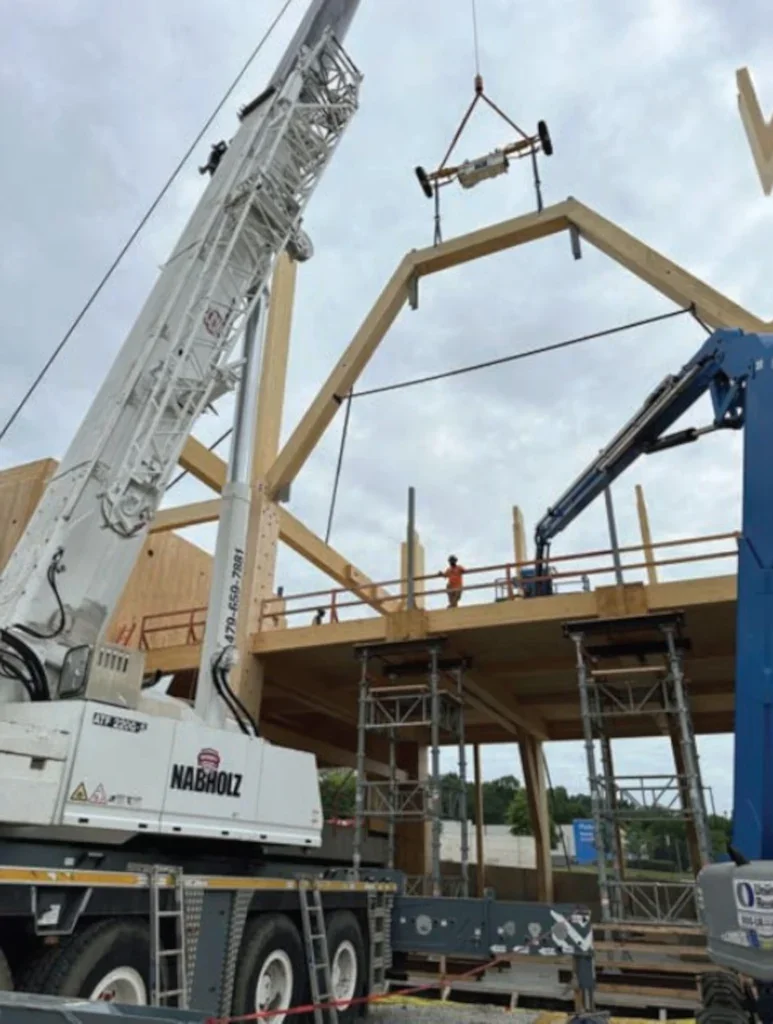
A key part of the system comprises the Dura-Mod modular spreader beam from The Caldwell Group.
The load navigator is available in five versions: in the 20-tonne capacity range it is available with a seven- or 11-foot beam; while in the 40 tonne capacity range it is available with seven-, 11- and 15-foot-long beams.
Vita Inclinata says the beam provides a versatile, lightweight alternative to fixed and multiple-point below the hook solutions.
One of Vita Inclinata’s customers was US construction company Nabholz which used the Vita Load Navigator for the construction of The Anthony Timberlands Center at the University of Arkansas.
The centre is being built out of cross-laminated timber and the load orientation device is key to lifting and accurately positioning the 62,000 cubic feet of timber required. It is also enhancing safety and achieving efficiencies.
“It’s a life-saver,” remarked Jeremy Doss, lead carpenter and assistant superintendent at Nabholz, recounting the importance of navigating large loads that can cause severe injuries if out of control or in unruly positions. “With the VLN panels never got out of control.”
“Removing the need for a person to hold onto a tagline carrying 1000 lbs. is a game-changer,” emphasised Dominic Urbino, lead rigger at Nabholz. “By doing so, we’re not only increasing efficiency but, more importantly, ensuring our team’s safety, which is always our top priority. At the end of the day, we want everyone to return home to their families, and tools like the VLN help us make that a reality.”
With regards to efficiency gains, the ability to optimise processes and cut down on installation time meant the project could progress more quickly and efficiently than ever before. The VLN’s performance significantly reduced the time and effort required, providing a clear advantage over traditional methods, says Vita Inclinata.
“Without the VLN, we’d set 4-5 panels [per hour],” noted Michael Powell – superintendent at Nabholz with 45 years of experience. “With it we were able to pick and set in a timelier fashion – just five minutes per panel instead of 15. The VLN proved particularly effective for vertical panels, weighing up to 12,000 lbs. and measuring between 20-35 ft. With a 1-degree plumb and squareness, the VLN offered optimal control, replacing the need for manual labour on each side.”
MODULIFT FACILITATES MAJOR LIFTING MILESTONE AT HINKLEY POINT C
Specialist lifting equipment manufacturer Modulift is facilitating civil engineering installation works at UK nuclear power station construction site Hinkley Point C.

One milestone moment saw the 730-tonne reactor cavity precast pool installed by Sarens’ SGC-250 (aka Big Carl) using Modulift underslung beams. This lift marked a significant step towards the UK’s first new nuclear power station in over a generation.
Bylor, a joint venture of Bouygues Travaux Publics and Laing O’Rourke, is the contractor delivering Hinkley Point C’s main civil engineering works.
Appointed in 2022 Modulift has delivered bespoke lifting systems tailored to the unique demands of this major infrastructure project.
Sarah Spivey, managing director at Modulift, said: “All lifting equipment is precisely designed using state-of-the-art engineering technology and Finite Element Studies. By leveraging our engineering expertise and 20+ years of experience in the nuclear sector, we ensure all lifting equipment adheres to rigorous UK compliance standards such as BS EN. We are proud to be part of such a critical energy project”.

Artur Osicki, temporary works lead at Bylor, said: “Modulift custom lifting beams play a crucial role in the ongoing construction of Hinkley Point C supporting the installation of key infrastructure elements. Modulift’s reputation for precision engineering and quality assurance provides us with the confidence that all equipment complies with regulations for the UK market.
“Each custom piece of equipment comes with comprehensive user instructions ensuring safe and efficient operations on site.”
Once complete Hinkley Point C is expected to deliver zero-carbon electricity to approximately six million homes.


